Equipes multifuncionais parecem ser a espinha dorsal da maioria das empresas de sucesso, já que um dose benefícios da colaboração é que ela impulsiona o desempenho no local de trabalho.
Mas, se você está apenas começando no mundo corporativo, pode estar se perguntando — o que são equipes multifuncionais? E, mais importante, quais são os exemplos de equipes multifuncionais que você pode consultar para criar o mesmo tipo de sinergia no seu local de trabalho?
Hoje, estamos respondendo a essas perguntas, bem como nos aprofundando nos seguintes tópicos:
- Quais são os benefícios das equipes multifuncionais?
- Como é a colaboração multifuncional eficaz?
- Quais são os maiores benefícios e desafios que as equipes multifuncionais enfrentam?
- Como podemos melhorar as maneiras como essas equipes colaboram?
Vamos lá!

- A colaboração multifuncional ou colaboração XFN é a colaboração entre pessoas de diferentes equipes ou departamentos, que têm um objetivo comum.
- No centro de toda equipe multifuncional estão a colaboração e a comunicação. As equipes XFN promovem o trabalho em equipe e a colaboração por meio de comunicação transparente, troca de ideias e compartilhamento de conhecimento.
- Os benefícios da colaboração multifuncional são: maior engajamento, funções definidas, maior criatividade e inovação, melhor alinhamento entre departamentos, comunicação aprimorada e agilidade empresarial aprimorada.
- As principais dicas para melhorar a colaboração em equipes multifuncionais são:
- Selecionar os membros certos da equipe,
- Fornecer treinamento
- Atribuir o líder certo
- Definir objetivos e KPIs claros
- Usar objetos de delimitação
- Utilizar recompensas e punições,
- Reconhecer o valor da diversidade
- Construir uma identidade comum
- Utilizar tecnologia colaborativa
O que é colaboração interfuncional?
A colaboração interfuncional ou colaboração XFN é a colaboração entre pessoas de diferentes equipes ou departamentos, que têm um objetivo comum.
Esse tipo de colaboração entre diferentes áreas permite que os membros da equipe usem suas diversas habilidades e conhecimento especializado, o que os ajuda a resolver problemas e a obter melhores resultados por meio de brainstorming.
O que é uma equipe interfuncional?
É um grupo de pessoas de diferentes partes funcionais de uma organização, que aplicam diferentes habilidades, são altamente interdependentes e trabalham juntas para atingir um objetivo comum.
Esses são grupos que consistem em um pequeno número de pessoas com habilidades complementares, que são mutuamente responsáveis e prestam conta entre si para:
- Melhorar o desempenho organizacional
- Reimaginar processos organizacionais
- Desenvolver novos produtos
- Melhorar o relacionamento com o cliente
No centro de cada equipe interfuncional estão a colaboração e a comunicação. Promover o trabalho em equipe e a colaboração por meio da comunicação transparente, troca de ideias e compartilhamento de conhecimento é o que permite que equipes multifuncionais sejam:
- Eficiente
- Adaptável
- Inovador
Um bom exemplo de uma equipe multifuncional seria uma equipe onde representantes de diferentes departamentos — vendas, marketing, produto, engenharia e P&D — trabalham juntos para melhorar seu produto e, por sua vez, a experiência do cliente.
Dê uma olhada na imagem abaixo para ver esta estrutura organizacional interfuncional.
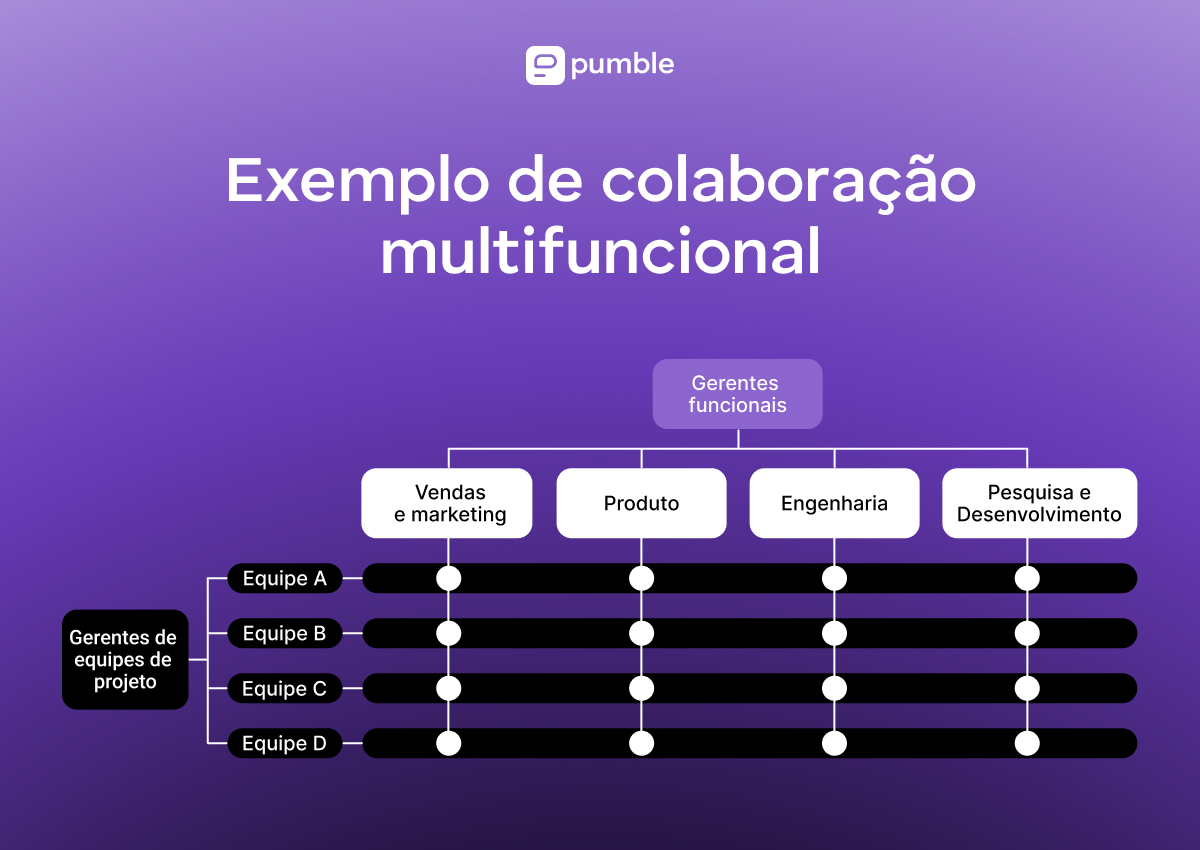
🎓 Dica profissional do Pumble
Embora as equipes intrafuncionais sejam vitais para qualquer organização, existem outras estruturas organizacionais de equipe que as empresas utilizam. Se você quiser aprender mais sobre vários tipos de equipes, pode dar uma olhada em nosso guia aprofundado:
Benefícios de equipes intrafuncionais
Qualquer tipo de trabalho colaborativo traz consigo seu próprio conjunto de prós e contras. Ainda assim, pesquisas mostram que, devido aos inegáveis benefícios da colaboração, o trabalho colaborativo aumentou nos últimos anos.
Mas quais são as vantagens específicas da colaboração interfuncional e quais benefícios os indivíduos podem ver em trabalhar com equipes interfuncionais?
Vamos dar uma olhada.
Benefício #1: Engajamento e motivação aprimorados
Trabalhar nas mesmas tarefas repetidamente pode matar até o mais forte dos entusiasmos. Mudar isso de tempos em tempos — trabalhando em uma equipe interfuncional, por exemplo — é a receita perfeita para maior engajamento, pois deixa as pessoas mais felizes.
Além disso, a colaboração faz com que as pessoas se sintam verdadeiramente parte da empresa. Este é um impulsionador de engajamento particularmente importante, como afirma um relatório da Kincentric sobre engajamento, que afirma que as pessoas que se sentem incluídas são 8,4 vezes mais engajadas do que aquelas que não se sentem.
Além disso, os membros de equipes interfuncionais são frequentemente encorajados a serem autônomos quando se trata de tomada de decisão e a assumir responsabilidade e propriedade de seu trabalho.
Isso, por sua vez, os torna mais engajados, já que tanto a autonomia quanto o reconhecimento são os principais impulsionadores do engajamento, de acordo com as Pumble’s Estatísticas de envolvimento dos funcionários que você precisa saber em 2023 do Pumble..
🎓 Dica profissional do Pumble
Se você quiser ver mais engajamento de seus colegas de trabalho ou funcionários, precisará fazer mais do que apenas dar a eles autonomia e reconhecimento. Para ver como você pode garantir níveis ótimos de engajamento, confira esta postagem:
Envolva seus funcionários com o Pumble
Benefício #2: Funções e objetivos definidos
Uma equipe interfuncional tem membros com conjuntos diversos de habilidades, bem como experiências — é isso que a torna tão eficaz.
No entanto, isso também tem um benefício adicional — as funções na equipe são claramente definidas. Se você tem Sally do Marketing trabalhando junto com John das Vendas para aumentar o engajamento do cliente, fica bem claro para John e Sally quem fará ligações não solicitadas e quem escreverá os scripts para elas.
Junto com funções claramente definidas, vêm responsabilidades claramente definidas e, finalmente, objetivos. Claro, isso não significa que cada membro de cada equipe saiba imediatamente qual é seu objetivo específico. Mas eles têm uma ideia geral.
🎓 Dica profissional do Pumble
Para saber mais sobre as funções da equipe e o papel que elas desempenham quando se trata do sucesso de qualquer esforço colaborativo, leia este guia:
Benefício #3: Maior criatividade e inovação
Trabalhar em uma equipe diversificada pode impulsionar a criatividade e a inovação em todos os membros. Uma revisão sistemática da literatura intitulada "Are Culturally Diverse Teams the More Creative Ones?" mostra que equipes diversificadas são mais criativas e inovadoras.
Claro, diversidade não basta. Os membros da equipe também precisam ter a mente aberta e é preciso haver apoio organizacional da gerência para que a equipe realmente prospere em termos de criatividade e inovação — algo que equipes multifuncionais geralmente têm.
Benefício #4: Melhor alinhamento entre departamentos
Quão bem você sabe o que Jenny do RH da sua empresa faz o dia todo? E Jane das Vendas? Você conhece as tarefas diárias dela? Você ao menos conhece a descrição do cargo de uma das duas?
Provavelmente não. Fora de seus colegas de equipe imediatos, as pessoas raramente estão familiarizadas com o que os indivíduos de outros departamentos estão fazendo.
Trabalhar em uma equipe interfuncional muda isso, pois pessoas de diferentes departamentos trabalham em estreita colaboração com aquelas com quem nunca tiveram contato antes. Isso, por sua vez, cria um melhor alinhamento multifuncional.
Benefício #5: Comunicação aprimorada
Uma necessidade em todas as equipes multifuncionais é a comunicação eficaz.
Essas equipes têm membros que vêm de diferentes origens e tiveram experiências diferentes, e é por isso que precisam ter habilidades de comunicação incríveis para comunicar seus pontos de vista, opiniões, soluções e desacordos de forma respeitosa.
Este é um benefício da colaboração interfuncional que não deve ser ignorado — estar em uma equipe multifuncional torna as pessoas comunicadoras melhores e mais eficazes, o que as torna membros mais versáteis da equipe.
🎓 Dica profissional do Pumble
Como nem todo mundo tem a oportunidade de trabalhar em uma equipe multifuncional e melhorar suas habilidades de comunicação através dessa experiência, aqui estão outras maneiras de garantir que seus colegas de equipe tenham habilidades de comunicação de alto nível:
Benefício #6: Agilidade empresarial aprimorada
Equipes multifuncionais não têm o obstáculo de esperar que a comunicação interdepartamental passe por todo o ciclo. Então, por causa de sua estrutura, elas conseguem se mover rapidamente.
Enquanto isso, graças à versatilidade de habilidades e conhecimento entre os membros da equipe, essas equipes também podem criar soluções inovadoras — algo benéfico para todos os negócios.
No entanto, é importante observar que nem todas as organizações veem benefícios em empregar equipes multifuncionais. Na verdade, em alguns casos, a diversidade funcional pode impactar negativamente o desempenho.
Continuando, os resultados que uma equipe alcança variam de acordo com o tamanho da empresa, sua infraestrutura interna e o setor ao qual pertence. Além disso, implementar estruturas, práticas e procedimentos empresariais eficazes exige muito esforço.
Quais são as características de uma equipe multifuncional eficaz?
Como sabemos se a parceria XFN recém-formada em uma equipe será eficaz?
Para responder a essa pergunta, temos que dar uma olhada mais de perto nas características de equipes interdepartamentais de alto desempenho. Quanto mais dessas características uma equipe tiver, maior a probabilidade de ser bem-sucedida.
Característica #1: Permanência
Como regra geral, equipes multifuncionais permanentes e de longo prazo têm mais chances de sucesso.
Se uma equipe for temporária, a organização pode não ver valor em melhorar o ambiente de trabalho dos membros da equipe criar um ambiente de trabalho positivo.
Quando uma empresa sabe que uma equipe será dissolvida assim que terminar um projeto, isso a torna muito menos propensa a atribuir recursos significativos a ela.
Então, quando uma equipe interfuncional se torna permanente, a gerência não pode ignorar suas solicitações por melhores condições de trabalho.
A longo prazo, os investimentos que uma organização faz para melhorar as condições de trabalho e melhorar a segurança psicológica de uma equipe multifuncional serão recompensados por meio de melhor desempenho.
🎓 Dica profissional do Pumble
Não investir recursos suficientes em sua equipe multifuncional pode levar a um desempenho ruim. Para descobrir outros fatores que podem contribuir para isso, leia o guia a seguir:
Garanta o melhor desempenho da equipe — alinhe seus objetivos no Pumble
Característica #2: Metas claras, convincentes e desafiadoras
Repetidamente, estudos têm mostrado que equipes multifuncionais têm melhor desempenho quando:
- Metas claramente definidas
- Desafios moderados
Sem objetivos claros, as pessoas perdem a motivação. Em contraste, com objetivos claros, elas sabem o que buscar sem cair na armadilha da falta de comunicação no ambiente de trabalho.
Ao mesmo tempo, é vital que os objetivos do projeto não sejam fáceis demais de alcançar — já que a falta de estímulo leva ao tédio — nem muito difíceis. Desafios difíceis ou inatingíveis podem levar ao desengajamento dos funcionários — os membros da equipe podem se distanciar dos objetivos da equipe.
Então, o equilíbrio é fundamental.
🎓 Dica profissional do Pumble
Definir metas claras que atinjam o equilíbrio perfeito entre muito fácil e muito difícil é um fardo enorme para muitos líderes e gerentes de equipe. Para ajudar você, escrevemos um guia completo sobre como definir metas para sua equipe:
Característica #3: Clima positivo
Equipes interfuncionais de alto desempenho priorizam um clima de trabalho positivo, valorizando o bem-estar individual dos membros da equipe.
Por exemplo, alguns líderes — especialmente aqueles que adotam um estilo de liderança que dita o ritmo — podem decidir que criar um senso de urgência enfatiza a importância de um projeto. No entanto, isso também cria tensão, o que leva a mais conflitos entre os membros da equipe.
Em contraste, outros — como um líder do tipo laissez-faire, por exemplo — podem ser muito flexíveis com as regras. Isso faz com que os funcionários não levem o projeto a sério, dificultando a execução de qualquer tarefa.
Uma abordagem relaxada, mas profissional, parece funcionar melhor para equipes interfuncionais eficientes.
🎓 Dica profissional do Pumble
Clima positivo é apenas um dos muitos fatores-chave que contribuem para uma colaboração de equipe ótima e eficaz. Para descobrir quais são os outros, leia este guia:
Característica #4: Empoderamento
Membros de equipe empoderados, que recebem um certo senso de autonomia quando se trata de tomar decisões sobre um projeto, mostram mais comprometimento em atingir os objetivos da empresa, mostra uma pesquisa.
Além disso, eles também apresentam níveis mais altos de satisfação no trabalho, o que pode levar a uma diferença de até 14% na produtividade dos funcionários, de acordo com a Gallup.
Além disso, a velocidade do desenvolvimento aumenta com o nível de liberdade e responsabilidade que os membros da equipe têm. Permitir que as equipes executem decisões reduz o tempo necessário para tomar decisões, resolver problemas e agir.
Então, a colaboração cresce quando as equipes têm permissão para fazer suas próprias regras e procedimentos
Característica #5: Liderança exemplar
Normalmente, os líderes de equipes interfuncionais produtivas não tomam medidas diretas para ajudar a terminar o projeto.
Em vez disso, a liderança interfuncional permite o processo de desenvolvimento — eles fornecem limites, mas também liberdade e autonomia quando se trata de tomada de decisão.
Outra maneira pela qual os líderes permitem a colaboração é implementando um estilo participativo de liderança, em que se espera que os membros da equipe compartilhem algumas das funções de liderança.
Essa liderança compartilhada é vital para navegar pelas complexidades de equipes multifuncionais, pois dá aos funcionários a liberdade de explorar, discutir e desafiar ideias sobre quais tecnologias adotar ou quais problemas resolver.
Característica #6: Suporte da alta gerência
O suporte da alta gerência pode ser crítico para o sucesso de uma equipe. Na verdade, é tão crítico que justifica um esforço estratégico para que os gerentes seniores mostrem mais suporte para equipes multifuncionais por meio de:
- Demonstração de comprometimento
- Ajuda com a superação de obstáculos da equipe
- Fornecimento de incentivos
Característica #7: Excelente comunicação
Indiscutivelmente, a característica mais importante de equipes interfuncionais bem-sucedidas é a comunicação eficaz.
Vemos muitos benefícios na comunicação entre os membros da equipe com altos níveis de confiança, honestidade e respeito mútuo, como:
- Melhor entendimento mútuo;
- Melhor colaboração;
- Aumento da produtividade;
- Aumento da criatividade;
- Aumento da adaptabilidade à mudança;
- Resolução de problemas mais eficaz;
- Melhor moral dos funcionários;
- Resolução de conflitos mais bem-sucedida;
- Melhor confiança;
- Entrada futura certificada.
Então, uma boa comunicação deve ser uma prioridade dentro de equipes multifuncionais. Mesmo que todos os outros requisitos técnicos sejam cumpridos, a falta de comunicação adequada ainda pode derrubar todo o esforço.
Quais são os principais desafios da colaboração interfuncional?
O ideal é que uma equipe interfuncional marque todas as caixas na folha imaginária de "características". No entanto, muitas equipes não o fazem, e é por isso que se veem diante de desafios específicos.
Vamos entrar nas especificidades de cada um desses desafios e depois ver o que as equipes interfuncionais podem fazer para superá-los.
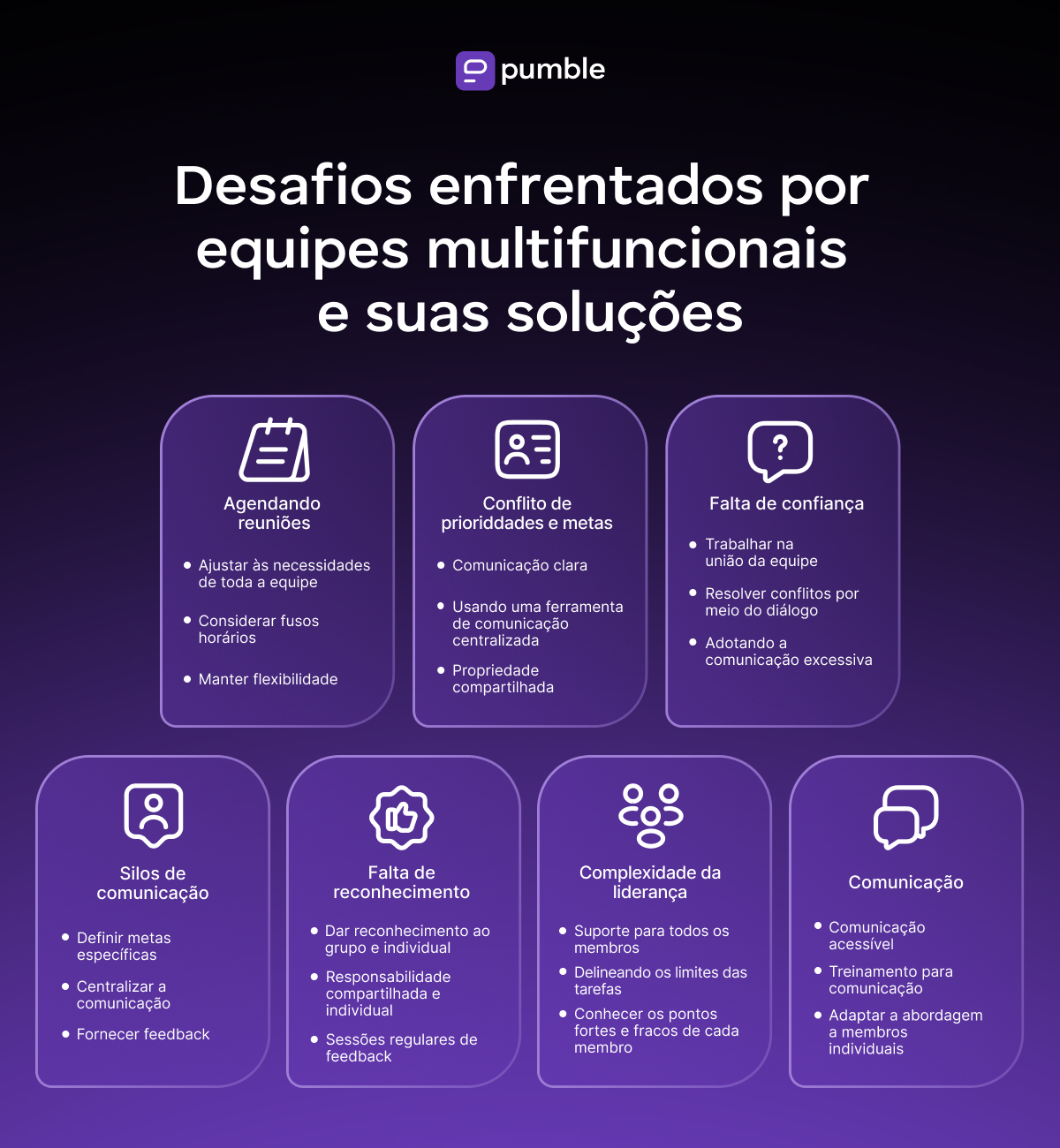
Desafio #1: Dificuldade em agendar reuniões
Quando consideramos diferentes tipos de modelos de trabalho, como trabalho remoto e híbrido, agendar reuniões fica um pouco mais complexo.
Agendar reuniões para equipes distribuídas com membros em fusos horários diferentes pode levar a mal-entendidos, confusão e pessoas frustradas sentadas sozinhas em uma videoconferência programada para começar em uma ou duas horas.
Além disso, os horários das reuniões geralmente são ajustados às necessidades dos líderes de equipe, devido ao seu lugar na hierarquia do local de trabalho.
Lidar com esse desafio inclui:
- Ajustar-se às necessidades de toda a equipe
- Sempre levar em consideração os fusos horários
- Manter a flexibilidade quando se trata de agendamento
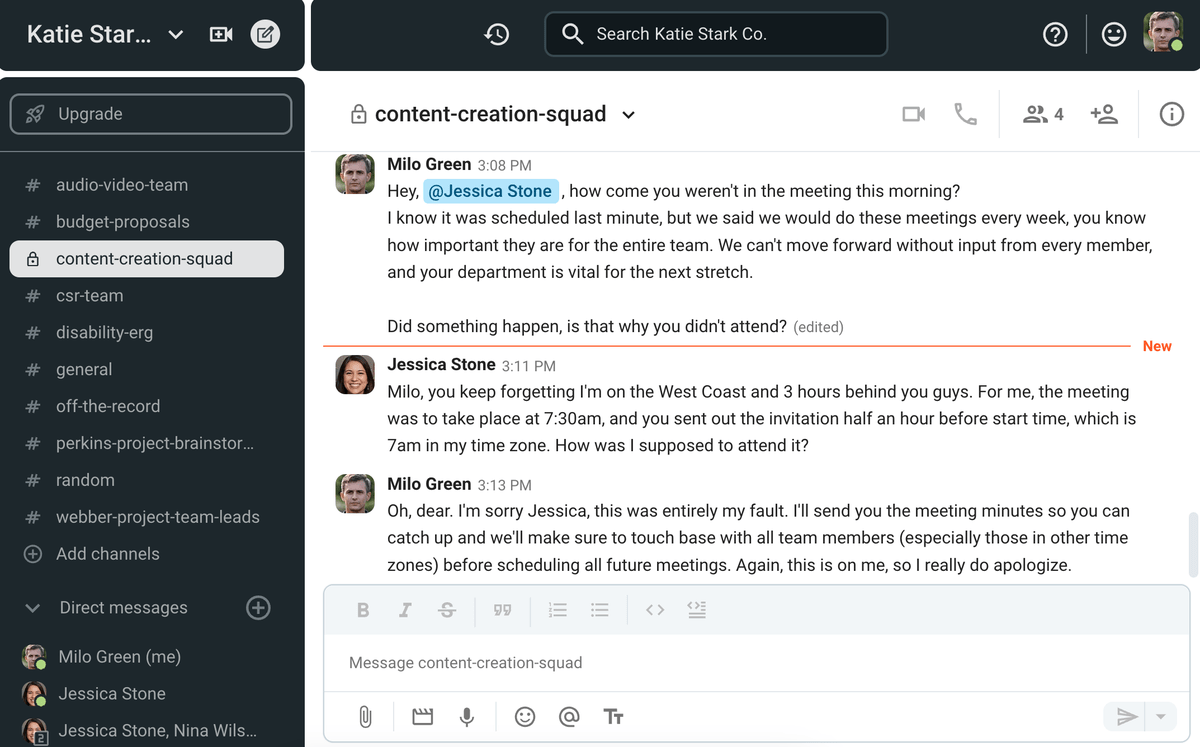
Agende reuniões facilmente pelo Pumble
🎓 Dica profissional do Pumble
Para descobrir como você pode ajudar sua equipe a trabalhar perfeitamente em diferentes fusos horários, dê uma olhada neste post:
Desafio #2: Prioridades e objetivos diferentes
Em seguida, temos situações em que as pessoas têm prioridades e objetivos funcionais diferentes. O primeiro problema pode ser atribuído principalmente à falta de comunicação entre diferentes equipes, como resultado de não ter um sistema de comunicação centralizado.
Da mesma forma, a falta de comunicação combinada com objetivos ambíguos resulta em objetivos mal interpretados. Devido à duração limitada da equipe do projeto, os funcionários raramente têm tempo para resolver suas diferentes maneiras de pensar, então seus esforços muitas vezes se tornam incoerentes.
Superar esse desafio em particular não é fácil, mas pode ser feito por meio de:
- Comunicação clara — A comunicação transparente pode ajudar os membros da equipe a permanecerem conectados.
- Uma ferramenta de comunicação centralizada — Uma ferramenta de comunicação como o Pumble que simplifica a comunicação permite que todos os membros se comuniquem e ajustem suas metas e expectativas de forma rápida e fácil.
- Propriedade compartilhada — Quando os membros da equipe se sentem igualmente responsáveis pelos objetivos do projeto, eles estarão mais inclinados a ter metas alinhadas.
Comunique-se e defina metas no Pumble
Desafio #3: Falta de confiança
A falta de confiança em equipes interfuncionais vem de colocar pessoas sem conhecimentos anteriores em um ambiente de alta pressão.
Isso resulta em grande desconforto para os membros da equipe, que não se sentem seguros o suficiente para se comunicar livremente. Consequentemente, as equipes tentam escapar do desconforto reduzindo os padrões para concluir o projeto antes do prazo, escapando efetivamente da situação.
Construir confiança em equipes leva tempo, mas você pode começar:
- Trabalhando na união da equipe — Criar oportunidades para que os membros da equipe se conheçam e criem um vínculo ajudará muito.
- Resolvendo conflitos por meio do diálogo — Deixar os conflitos se acumularem sem abordá-los nunca é uma boa ideia.
- Adotando a comunicação excessiva — Equipes com muitos membros de diferentes departamentos não podem se dar ao luxo de ter falta de comunicação, e é por isso que elas devem aprender a se comunicar excessivamente.
🎓 Dica profissional do Pumble
Construir confiança em uma equipe não é fácil, especialmente quando a equipe está funcionando totalmente remotamente. Para obter as melhores dicas sobre como construir confiança em sua equipe, confira esta postagem:
Desafio #4: Silos de comunicação
Devido à sua natureza — sendo compostas por pessoas de diferentes unidades funcionais — equipes interfuncionais correm um risco maior de desenvolver silos intra-equipe.
Por exemplo, engenheiros podem achar difícil trabalhar com designers, pois eles têm abordagens distintamente diferentes para trabalhar.
Então, em uma equipe interfuncional, eles podem recorrer a ficar sozinhos, criando os infames silos. Isso era verdade mesmo antes da pandemia da COVID-19, mas é especialmente pertinente agora com muitas empresas adotando a abordagem remota primeiro, o que limita as oportunidades de colaboração.
Para garantir que todos os membros da equipe estejam colaborando sem criar silos, você deve:
- Definir metas específicas que exijam o esforço de todos
- Use uma ferramenta de colaboração centralizada para evitar a comunicação indireta
- Fornecer feedback e incentivar outros a darem feedback aos seus pares
🎓 Dica profissional do Pumble
Para saber mais sobre estratégias que você pode usar para lidar com silos, confira este artigo:
Desafio #5: Falta de reconhecimento
Quando os funcionários sentem que não têm recompensas e reconhecimento adequados por seus esforços, eles não têm incentivo para executar o melhor de suas habilidades.
Portanto, quando a colaboração da equipe é encorajada, mas não recompensada adequadamente, os funcionários podem sentir que é muito esforço com pouco em troca.
Lidar com os problemas que surgem da falta de reconhecimento é relativamente simples — sempre garanta que você ofereça reconhecimento individual e em grupo e incentive as pessoas a serem responsáveis por seu trabalho.
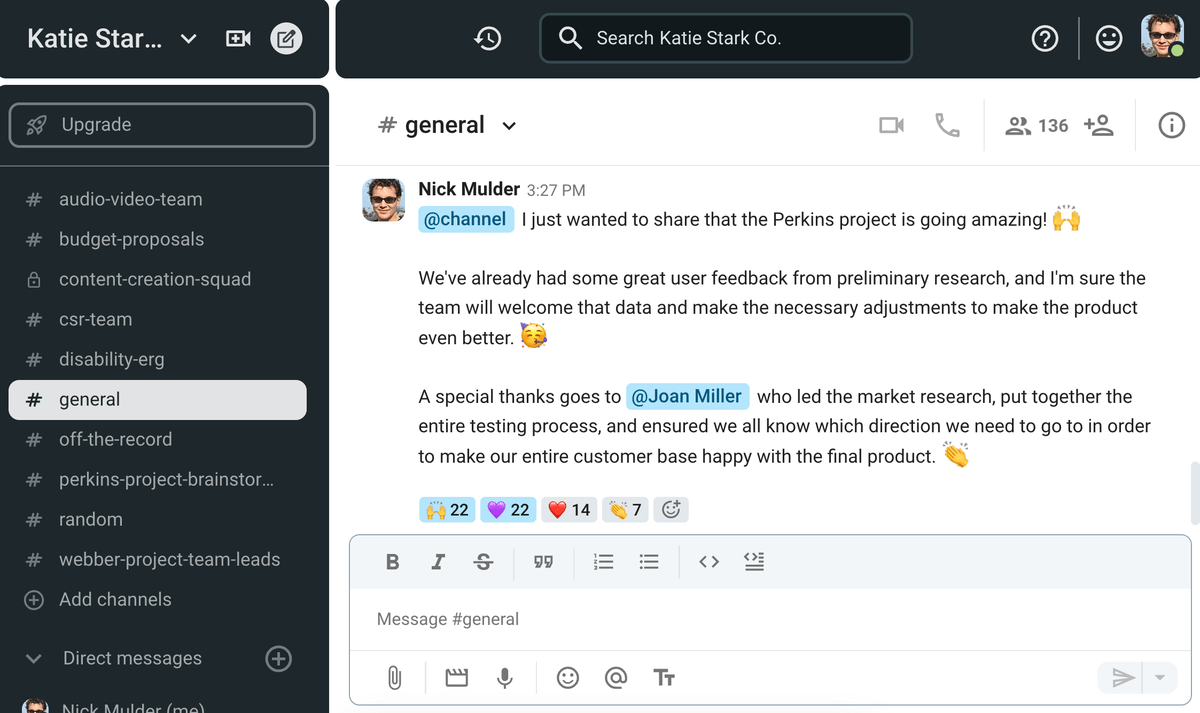
Demonstre reconhecimento e faça elogios ao Pumble
Desafio #6: Complexidade do papel do líder
Devido à complexidade do papel do líder de equipe, provavelmente é melhor contratar alguém com habilidades comprovadas em liderar equipes multidisciplinares que possa dar suporte a todos os membros da equipe, pois consegue distinguir facilmente seus pontos fortes e fracos.
Um líder com pouca experiência anterior pode achar difícil conciliar as necessidades dos funcionários de diferentes áreas funcionais. Além disso, eles podem ter dificuldade em delinear tarefas e combinar os esforços de todos os membros da equipe em um sistema produtivo.
🎓 Dica profissional do Pumble
Se você está apenas começando no campo gerencial e está preocupado em não fazer o certo pela sua equipe, confira esta postagem:
Desafio #7: Falta de comunicação (eficaz)
Existem inúmeras barreiras à comunicação eficaz, decorrentes de razões como limitações físicas, barreiras emocionais e culturais, diferenças de personalidade, etc.
Em equipes multifuncionais, isso leva a mal-entendidos, frustração e tensão no local de trabalho.
Mas, o mais importante, uma comunicação ruim ou negativa dificulta a realização dos objetivos que a equipe foi criada para alcançar. Isso significa que a qualidade da comunicação entre os membros da equipe pode ser decisiva para o sucesso ou fracasso de todo o projeto.
Algumas pesquisas sobre estrutura de equipe em equipes multifuncionais mostram que há uma correlação entre comunicação e tamanho do grupo.
Ou seja, pequenas equipes multifuncionais devem aumentar a comunicação para facilitar a resolução criativa de problemas, enquanto grandes equipes devem tentar não se comunicar demais para não sobrecarregar os membros da equipe.
No entanto, de qualquer forma, a comunicação da equipe precisa ser eficaz.
🎓 Dica profissional do Pumble
Garantir uma comunicação adequada em equipes multifuncionais exige muito planejamento. Para saber como planejar melhor a comunicação interna da sua equipe, leia este artigo:
Melhorando as equipes XFN — 10 melhores dicas e exemplos
Superar os desafios que as equipes multifuncionais enfrentam não é simples. No entanto, nós criamos as 10 melhores dicas e exemplos concretos de como você pode garantir que suas iniciativas multifuncionais não falhem.
Vamos dar uma olhada.
Dica #1: Selecione os membros certos da equipe
Selecionar os membros certos da equipe é o primeiro passo crítico para estabelecer uma colaboração interdivisional bem-sucedida.
Pedimos a Michele Olivier, consultora principal e fundadora da O&H Consulting, alguns conselhos sobre como selecionar esse tipo de funcionário e onde você pode errar. Na opinião dela, uma equipe multifuncional precisa de pessoas que trabalhem bem em equipe, em vez de representantes de todos os departamentos.

"Primeiramente, o que muitos empregadores fazem agora é ter representantes de todas as diferentes áreas se reunindo com o candidato e avaliando como eles trabalhariam com ele. Isso resulta em muitas entrevistas e poucas informações exclusivas. O que é necessário é um candidato que possa trabalhar perfeitamente de forma interfuncional e se envolver com as partes interessadas — internas e externas. Ter todos os departamentos opinando não estabelece isso realmente.."
Ela continua a dividir o termo “colaboração multifuncional” em vários componentes mais facilmente mensuráveis:

- "Uma habilidade de comunicar ideias complexas de forma simples e em uma linguagem compreendida por todos
- Habilidades de questionamento com disposição para fazer perguntas suficientes para realmente entender as necessidades e o processo de uma área desconhecida
- Ser capaz de motivar/treinar pessoas que não estão dentro da sua linha de reporte
- Uma disposição para admitir seus erros e mudar de rumo”
A outra pré-condição para uma colaboração bem-sucedida que você deve cuidar é que todas as áreas funcionais necessárias da empresa sejam representadas nas proporções corretas. Isso significa que você deve encontrar um equilíbrio entre muitas pessoas fazendo a mesma coisa e pisando nos pés umas das outras e, por outro lado, pessoas se esgotando tentando atingir objetivos irrealistas.
Exemplo de seleção dos membros certos da equipe
Kayla, uma gerente de contratação, tem a opção de contratar dois designers com currículos igualmente impressionantes. Onde ela toma a decisão é ao comparar perguntas de entrevista destinadas a avaliar o quão abertos eles são. Um candidato expressou uma atitude desafiadora quando questionado sobre admitir erros, então Kayla escolhe o outro candidato, mais agradável.
Dica #2: Forneça treinamento apropriado
Todas as equipes podem se beneficiar ao fornecer treinamento apropriado para seus membros. Você deve tentar fornecer todos os recursos necessários para demonstrar métodos e ferramentas que os membros da equipe podem usar durante seu trabalho.
Com isso, queremos dizer tanto o lado técnico das coisas quanto às instruções sobre como lidar com conflitos interpessoais e comunicação. Dessa forma, você prepara os funcionários para os desafios que eles podem esperar enfrentar.
Exemplo de treinamento apropriado
Angela é uma agente recém-contratada em suporte ao cliente em uma empresa de SaaS. Durante sua primeira semana, ela passa por um treinamento completo sobre como usar as tecnologias que sua empresa usa internamente. Isso inclui instruções sobre como usar software de gerenciamento de projetos, espaços de trabalho online e software de controle de tempo.
Em seguida, ela é apresentada ao produto que a empresa hospeda. E, finalmente, Angela passa por reuniões com o RH, para se familiarizar com como lidar com conflitos e a quem recorrer se precisar de ajuda. Ela agora está apta a lidar de forma independente com suas responsabilidades.
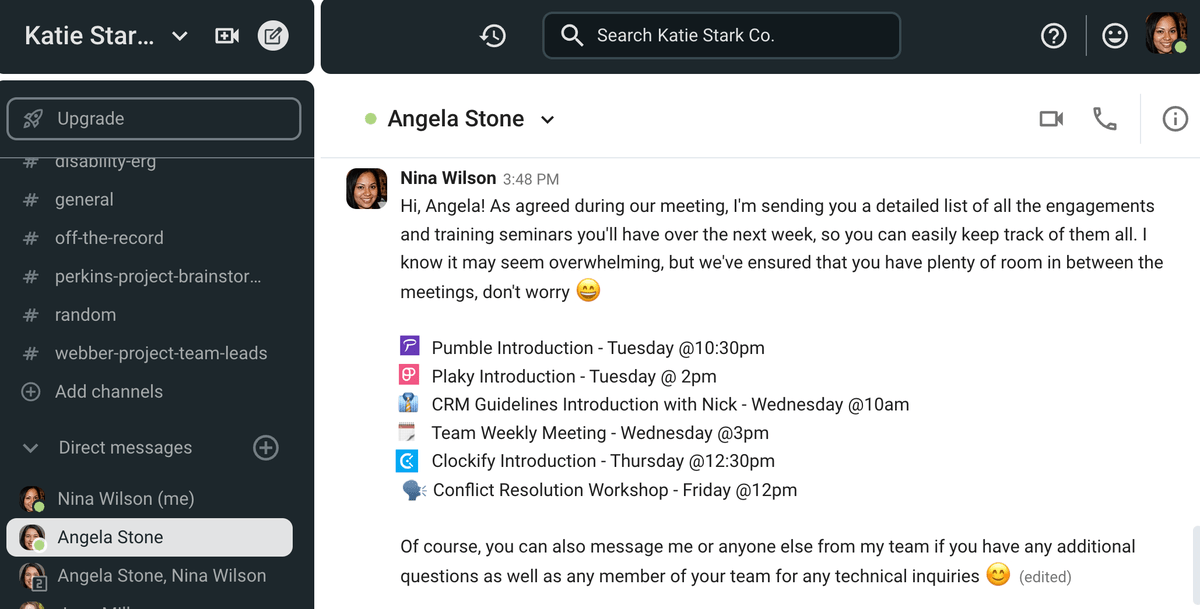
Incorpore e treine funcionários no Pumble
Dica #3: Designe um líder experiente
Uma pessoa com experiência em equipes interdisciplinares será mais eficaz para colaboração interfuncional do que um líder que só liderou equipes tradicionais.
Essas pessoas acharão mais fácil ser proativas em situações em constante mudança. Elas estão prontas para dar olhar com objetividade todas as vantagens e desvantagens do processo de desenvolvimento e tomar medidas para melhorá-lo.
Em suma, líderes experientes têm uma visão mais perspicaz do processo de produção e são capazes de encontrar soluções que atendam às expectativas da empresa.
Exemplo de designação de um líder experiente
Austin foi o líder inicial de uma equipe responsável pelo design do produto. Infelizmente, ele teve problemas com a coordenação dos membros da equipe, o que levou a não terminar um projeto importante no prazo e a perder um cliente de longo prazo.
Com isso em mente, a empresa designa Jason como o novo líder da equipe. Jason tem bastante experiência comprovada em liderar equipes responsáveis pelo desenvolvimento de novos produtos. Ele também mudou de carreira em algum momento, o que lhe dá a capacidade de ver os problemas de diferentes perspectivas e ser muito mais organizado e produtivo.
Dica #4: Defina objetivos organizacionais claros
Estabelecer metas organizacionais claras fornece um quadro de referência comum para a equipe. Ter objetivos definidos ajuda a estruturar tarefas e cria limites para sua realização.
Quando se trata de limites, queremos dizer especificamente:
- Prazos definidos para a conclusão do projeto
- Um cronograma de avaliação definido
- Um cronograma de reuniões
Você pode fazer isso empregando os princípios de liderança estratégica e mudando a prioridade de táticas para estratégias, e de produção para resultado.
Isso permite que os funcionários se sintam mais envolvidos e cria um ambiente melhor para colaboração.
Exemplo de definição de objetivos organizacionais claros
Uma nova startup tem apenas um objetivo:
“Desenvolver um produto competitivo em nosso nicho com o mínimo de recursos possível.”
Todos os outros processos e estruturas internas são organizados em torno deste princípio. Então, os funcionários sempre sabem enfatizar soluções acessíveis e eliminar todas as despesas desnecessárias.
Além disso, eles são orientados a focar em produtos e serviços com valor de mercado comprovado, então a inovação é um tanto limitada. Essa prática se estende ao processo de contratação, pois eles procuram menos, mas mais funcionários experientes.
Comunique objetivos e metas pelo Pumble
Dica #5: Crie indicadores-chave de desempenho
Uma maneira eficaz de monitorar o desempenho é criar indicadores-chave de desempenho (ICDs). Os ICDs são metas estratégicas expressas em valores mensuráveis. Eles são um meio objetivo de medir a colaboração.
Alguns dos ICDs se concentram em medir o desempenho financeiro — por exemplo, Lucro Líquido ou Taxa de Crescimento da Receita.
Outros prestam atenção ao feedback do cliente, medindo o Customer Satisfaction Score ou rastreando o Net Promoter Score.
Exemplo de uso de ICD para medir a colaboração multifuncional
Susan é uma líder de equipe para uma equipe multifuncional formada para melhorar a satisfação do cliente. Para medir o sucesso da equipe em atingir sua meta, Susan decide usar os seguintes KPIs:
- Pontuação de satisfação do cliente
- Taxa de retenção de clientes
- Pontuação do promotor líquido
Quanto à eficácia da equipe, ela decide implementar o Employee Engagement Index, Employee Satisfaction Score, as well as Revenue Growth, bem como a Taxa de Crescimento da Receita para ver como as coisas progridem no lado financeiro.
🎓 Dica profissional do Pumble
Para obter uma visão mais detalhada sobre como medir a colaboração com ICD, visite nosso guia:
Dica #6: Use objetos de limite
Para combater a diferença entre o conhecimento profundo dos membros da equipe, você pode usar os chamados objetos de fronteira ou definições tangíveis. Esses objetos são representações pragmáticas usadas para informar múltiplas comunidades.
Objetos de limite podem ser:
- Objetos ou artefatos de limite concreto — objetos estáveis e reconhecíveis, usados como contêineres de significado para facilitar a colaboração.
- Objetos de limite epistêmico ou objetos epistêmicos — fluidos, incompletos e em constante evolução para atender às necessidades de explicar a diferença entre o conhecimento entre os membros da equipe.

Exemplo de uso de objetos de limite
Jake é um líder de equipe responsável por colocar uma linha de fábrica em funcionamento. Ele decide usar um objeto de limite para delinear para todos os membros da equipe quais são as expectativas.
Para fazer isso, Jake acredita que o objeto de limite mais eficiente é um protótipo de máquina que demonstra os mecanismos em funcionamento. Este protótipo serve para preencher a lacuna entre engenheiros e operadores de máquina, estabelecendo uma colaboração mais bem-sucedida.
Dica #7: Seja transparente sobre recompensas e repercussões
Tanto recompensas quanto repercussões são maneiras eficientes de motivar funcionários. No entanto, elas funcionam de maneiras diferentes.
Com uma recompensa em mente, as pessoas se esforçam para ter um desempenho melhor. Da mesma forma, quando "punições" são discutidas abertamente, isso dá aos funcionários um incentivo para permanecerem no caminho certo. Essa regra é simples, mas frequentemente esquecida.
Exemplo de transparência de recompensa e repercussão
Kaytlin é contadora e sabe que se perder outro prazo para entregar sua tarefa, perderá sua oportunidade de promoção até o próximo período de avaliação. Então, ela trabalha muito duro e tenta organizar seu tempo da forma mais eficiente possível.
Promova uma comunicação transparente com o Pumble
Dica #8: Reconheça o valor da diversidade no trabalho
Aqui temos dois tipos diferentes de diversidade em mente — uma é a diversidade de pessoas e a outra é a diversidade funcional.
Quando se trata da diversidade de pessoas, é importante tomar uma posição sobre a discriminação de pessoas de acordo com sua raça, gênero e sexualidade. Você deve se certificar de que o local de trabalho seja acolhedor para todos os tipos de pessoas.
O outro tipo de diversidade é a diversidade funcional de grupos multifuncionais. Quando muitas unidades funcionais são representadas em uma equipe, há um aumento na variedade de informações disponíveis.
Portanto, os membros da equipe têm a chance de visualizar o projeto de várias perspectivas.
Exemplo de contratação de uma equipe diversa
Craig é um gerente de Aquisição de Talentos que decidiu tentar uma abordagem experimental para contratar uma equipe diversa. Para evitar preconceitos, ele publica uma vaga de emprego, mas solicita que os candidatos excluam qualquer informação (incluindo nome e fotos) que possa revelar sua idade, sexo, raça ou sexualidade. Ele então pede aos candidatos que atendem aos requisitos para concluir uma tarefa.
Depois que ele seleciona as pessoas com as habilidades para concluir a tarefa com sucesso, o grupo de candidatos é significativamente menor. Só então Craig convida os candidatos para reuniões presenciais e videoconferências. Como resultado, ele tem certeza de que seu preconceito pessoal teve efeito mínimo na pessoa que ele seleciona para o trabalho.
🎓 Dica profissional do Pumble
Para ajudar você a ter suas equipes o mais diversas possível, preparamos dois guias diferentes que poderão ajudá-lo. Confira:
Dica #9: Crie uma identidade comum
Promover uma identidade comum — o "nós" em uma equipe — tem muitos benefícios. Primeiro, o senso de unidade dá às pessoas motivação para se esforçarem mais para atingir as metas da equipe.
Para melhor realizar isso, implemente uma estrutura de equipe especial que delegue autoridade de tomada de decisão à equipe. Recompensas coletivas também aumentam o senso de comunidade. Um evento de construção de equipe, por exemplo, também é uma atividade que aumenta o senso de identidade comum.
Exemplo de construção de uma identidade comum
Carrie é membro do RH em uma empresa de desenvolvimento de software. Ela decide que uma boa atividade para construir uma identidade comum é participar de uma atividade de plantio de árvores. Para ela, essa é a solução ideal, pois é boa para o meio ambiente e permite que os funcionários passem um dia na natureza, se conhecendo melhor.
Dica #10: garanta que sua pilha de tecnologia permita a colaboração
As equipes colaboram melhor quando têm uma ideia clara do que cada um está realmente fazendo. A maneira mais fácil de fazer isso acontecer é usando tecnologia de colaboração em equipe de qualidade, como o Pumble.
Além disso, a tecnologia que você usa é melhor quando centralizada, permitindo recursos de mensagens, videoconferência, e compartilhamento de arquivos.
Exemplo de uso da tecnologia para permitir a colaboração
No exemplo a seguir, temos Steve, Fiona e Harry agendando uma visita às lojas, em busca de inspiração para uma nova linha de culinária. O aplicativo de comunicação da equipe permite que todos expressem suas opiniões, bem como reajam com emojis ao que leem.
Se eles sentirem necessidade de entrar em contato com outros membros da equipe, eles sempre podem verificar o status e adicioná-los à conversa do grupo.
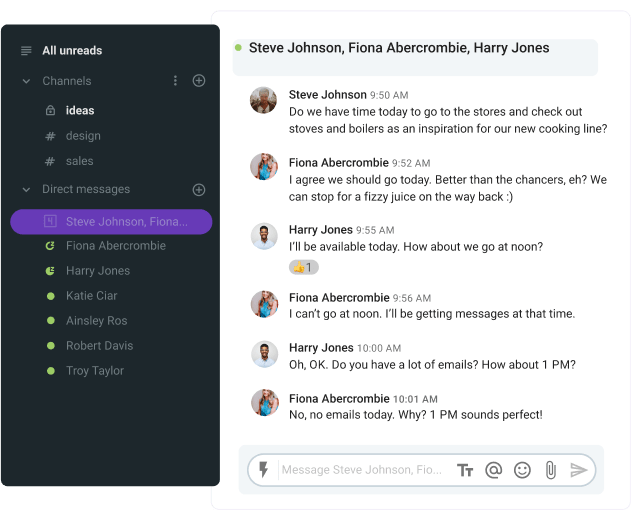
Comunique-se facilmente com toda a sua equipe no Pumble
Dicas adicionais: Avaliação de candidatos potenciais para equipes XFN
Como nossa especialista, Michele Olivier, mencionou, há quatro habilidades que todo membro de uma equipe interfuncional precisa ter:
- Capacidade de comunicar ideias complexas em linguagem simples
- Habilidades de questionamento
- Ser capaz de motivar e orientar pessoas fora da linha de reporte
- Disposição para admitir erros e mudar de rumo
Então, para garantir que temos as pessoas certas para nossa equipe multifuncional, temos que avaliar cada uma delas.
Habilidade #1: Comunicar ideias complexas em linguagem simples
Para avaliar essa habilidade e garantir que o candidato tenha habilidade para explicar algo para que todos o entendam, Michele aconselha:

“Peça a um membro não técnico da equipe (RH, CS, recrutador, etc.) para fazer uma pergunta técnica relevante para a função. Explique ao candidato que ele não é técnico e que precisará de uma versão simplificada. Então, peça a essa pessoa que avalie o candidato em:
1. Clareza da explicação
2. Verificação de compreensão em todo o texto
3. Falta de uso de jargões do setor,
4. Capacidade de responder a perguntas de acompanhamento.”
Habilidade #2: Habilidades de questionamento
Em seguida, devemos avaliar o nível de disposição que um candidato tem de fazer perguntas suficientes para realmente entender as necessidades e o processo de uma área desconhecida.
Michele acredita que as habilidades de questionamento podem ser facilmente avaliadas com algumas perguntas de entrevista mais típicas.

“Isso inclui dar aos candidatos um cenário para se envolverem e perguntar como eles abordariam isso. Ao fazer isso, você deve limitar intencionalmente a quantidade de informações fornecidas e deixá-los saber que eles podem perguntar qualquer coisa que precisarem. Então, procure por perguntas sobre a premissa básica, como o que estamos tentando alcançar ou quem é o stakeholder.”
Habilidade #3: Motivar e treinar pessoas fora de sua linha de reporte
De acordo com Olivier, avaliar essa habilidade em particular é bem fácil com as perguntas certas, como estas:

1. “Conte-me sobre uma ocasião em que você teve que motivar alguém, fora de sua linha direta de reporte, para atingir uma meta profissional.”
2. “Como você traz pessoas resistentes ao local?“
“Dê-me um exemplo de uma ocasião em que você teve que dar um feedback difícil a alguém.“
Habilidade #4: Vontade de admitir erros e mudar de rumo
Quando se trata de avaliar a disposição de admitir erros e mudar de rumo, de acordo com Olivier, algumas das melhores perguntas a serem feitas podem ser:

1. “Conte-me sobre a última vez que você errou no trabalho.”
2. “Quando foi a última vez que você mudou um processo ou abordagem?”
3. “O que inspirou a mudança?”
4. “Como você sabia se a mudança foi bem-sucedida?”
O processo de contratação é o momento perfeito para avaliar o potencial de colaboração de um candidato. Se você fizer isso corretamente, corre um risco muito menor de o candidato não ser adequado para a equipe existente. Como resultado, estabelecer uma colaboração eficaz é mais direto.
Aperfeiçoe sua colaboração interfuncional com o Pumble
A colaboração interfuncional não é fácil, mas, com muito esforço e as ferramentas certas, você pode garantir que seu ambiente multifuncional funcione sem problemas e sem esforço.
Sabemos que a comunicação é a principal necessidade para equipes multifuncionais. Com o Pumble — um aplicativo de comunicação e colaboração de equipe — a comunicação é centralizada, transparente e acessível.
O Pumble pode ajudar você a acompanhar o que sua equipe multifuncional está fazendo graças a:
- Grupos dedicados
- Mensagens diretas
- Chamadas de áudio
- Videoconferência
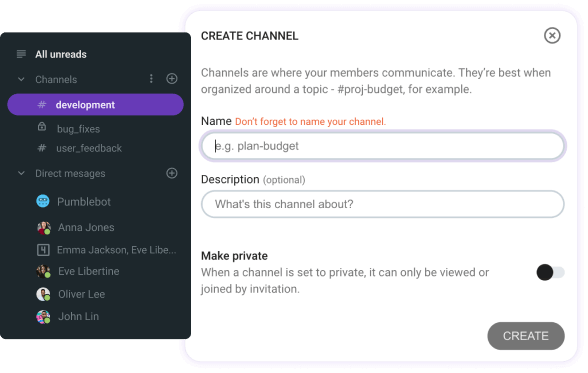
Com o Pumble, o compartilhamento de conhecimento e arquivos é mais fácil do que nunca, já que você pode enviar documentos de qualquer tamanho de qualquer dispositivo. Além disso, você pode acompanhar todos eles sem esforço, graças aos recursos de classificação e filtro.

Altamente personalizável, fácil de usar e familiar a todos — o Pumble é a escolha perfeita para equipes multifuncionais. Então, não hesite — melhore a colaboração e a comunicação da sua equipe e alcance os objetivos da empresa!
Como avaliamos esta publicação: Nossos escritores e editores monitoram as postagens e as atualizam quando novas informações ficam disponíveis, para mantê-las atualizadas e relevantes.





